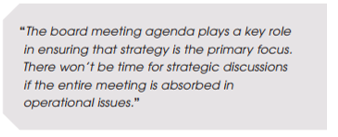By Amy Williams, CAE, MPA, Vice President of Sales and Consulting (Updated January 2021)
Focusing on strategic rather than operational issues can be a challenge for nonprofit boards for a variety of reasons. Board members may lack strategic governance experience because they manage operations in their day jobs. Their previous volunteer experience may have been on a chapter or local community board, which tends to be more operational out of necessity because there is limited staff support. There could be confusion about their roles as board members – they are expected to govern collectively and execute individually; this can be especially confusing if board members also function as committee chairs. Staff could be inviting the board to focus on operational issues by providing predominately administrative information to the board. Finally, they may simply not have time – a one-hour board call every month doesn’t allow much time for strategy.
First, the board must prepare itself to give up traditional areas of involvement. This starts with the nomination process. Nominations and elections should be based on competencies and qualifications, not popularity or availability. The nominating committee should recruit candidates to ensure a diverse mix of skill sets and personalities on the board. The board orientation program should familiarize new board members with their strategic responsibilities and expectations, and there should be on-going board development sessions to keep board members updated on trends and good governance. There needs to be collective buy-in from the board on the need to be more strategic so that they can police themselves when conversations start to digress into operations.
The board meeting agenda plays a key role in ensuring that strategy is the primary focus. There won’t be time for strategic discussions if the entire meeting is absorbed in operational issues.  Use a consent agenda to approve operational items, such as minutes and committee reports, under one motion without additional discussion. Make sure the right items are on the agenda and clearly spell out how they align with the strategic planning goals.
Use a consent agenda to approve operational items, such as minutes and committee reports, under one motion without additional discussion. Make sure the right items are on the agenda and clearly spell out how they align with the strategic planning goals.
Preparation for the board meeting is key – send materials out well in advance, make sure adequate information is provided and that board members review the materials prior to the meeting. Board members should ask for clarifying information before the meeting after they’ve reviewed the materials. At the board meeting, don’t spend time discussing an item if there isn’t enough information. Rather than taking time away from strategic discussions by considering “what if” scenarios, determine what information is needed, how you will obtain it, and agree to consider the issue again at the next board meeting.
Including a dashboard report or “strategy on a page”, which displays the strategic plan in a digestible format, in the board materials allow the board to see progress towards goals and keeps the plan top of mind.
You’ve prepared the board to be more strategic, you’ve freed up time on the agenda, and are keeping strategy top of mind – now what? Foster discussions that allow the board to think strategically.
Pose catalytic questions to the board that encourages innovation and creativity. For example, “what do you hope will be most different about our association in five years?” or “what is the biggest gap between who we want to be (vision) and who we actually are?” or finally, “what headline would you most like to see about our association?”
Before discussing a major issue, anonymously survey board members and ask questions such as: What should top our agenda next year? What are we overlooking? What is the most valuable thing we could do to advance the organization? What are the best and the most concerning aspects of the strategic plan? An analysis of the response, not the most outspoken board members, then drives the discussion.
Have the board read a thought-provoking, discussion-inducing book on the future of associations. Recommendations include:
- Race for Relevance: 5 Radical Changes for Associations, by Harrison Coerver and Mary Byers
- Road to Relevance: 5 Strategies for Competitive Associations, by Harrison Coerver and Mary Byers
- The End of Membership as We Know It: Building the Fortune-Flipping, Must-Have Association of the Next Century, by Sarah L. Sladek
- The Art of Membership: How to Attract, Retain and Cement Member Loyalty, by Sheri Jacobs
Another way to foster strategic discussion is to develop a master calendar that indicates which strategic topic(s) will be discussed at each meeting. Inform the board in advance of any reading or research needed prior to the discussion so the board is prepared. At the board meeting, suspend the rules of order and have a more informal conversation that encourages full participation from each board member.





